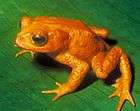Extinct in the wild
| Conservation status | |
|---|---|
 | |
| Extinct | |
| Threatened | |
| Lower Risk | |
|
Other categories | |
| |
|
Related topics | |
|
| |

An extinct in the wild (EW) species is one which has been categorized by the International Union for Conservation of Nature as only known by living members kept in captivity or as a naturalized population outside its historic range due to massive habitat loss.[1]
Examples
Examples of species and subspecies that are extinct in the wild include:
- Alagoas curassow (extinct in the wild since 1988)
- Black soft-shell turtle (extinct in the wild since 2002)
- Escarpment cycad (extinct in the wild since 2006)[2]
- Guam rail (extinct in the wild since the 1980s)
- Hawaiian crow or ʻalalā (extinct in the wild since 2002)
- Scimitar oryx (extinct in the wild since 1998)
- Socorro dove (extinct in the wild since 1972)
- Wyoming toad (extinct in the wild since 1991)
The Pinta Island tortoise (Geochelone nigra abingdoni) had only one living individual, named Lonesome George, until his death in June 2012.[3] The tortoise was believed to be entirely extinct in the mid-20th century, until Hungarian malacologist József Vágvölgyi spotted Lonesome George on the Galapagos island of Pinta on 1 December 1971. Since then, Lonesome George has been a powerful symbol for conservation efforts in general and for the Galapagos Islands in particular.[4] With his death on 24 June 2012, the subspecies is again believed to be extinct.[5] With the discovery of 17 hybrid Pinta tortoises located at nearby Wolf Volcano a plan has been made to attempt to breed the subspecies back into a pure state.[6]
Not all species that are extinct in the wild are rare. For example, Ameca splendens, though extinct in the wild,[7] was a popular fish among aquarists for some time, but hobbyist stocks have declined quite a lot more recently, placing its survival in jeopardy.[8] However, the ultimate purpose of preserving biodiversity is to maintain ecological function. When a species exists only in captivity, it is ecologically extinct.
Reintroduction
Reintroduction is the deliberate release of species into the wild, from captivity or relocated from other areas where the species survives. This may be an option for certain species that are endangered or extinct in the wild. However, it may be difficult to reintroduce EW species into the wild, even if their natural habitats were restored, because survival techniques, which are often passed from parents to offspring during parenting, may be lost. While conservation efforts may preserve some of the genetics of a species, the species may never fully recover due to the loss of the natural memetics of the species.
See also
- IUCN Red List extinct in the wild species for a list by taxonomy
- Category:IUCN Red List extinct in the wild species for an alphabetical list
- Extinction
Notes and references
- ↑ IUCN, 2001 IUCN Red List Categories and Criteria: Version 3.1 p.14 Last visited: 30 May 2010.
- ↑ Donaldson, J.S. (2009). "Encephalartos brevifoliolatus". IUCN Red List of Threatened Species. Version 2010.4. International Union for Conservation of Nature.
- ↑ Gardner, Simon (6 February 2001). "Lonesome George faces own Galapagos tortoise curse".
- ↑ Nicholls, H (2006). Lonesome George: The Life and Loves of a Conservation Icon. London: Macmillan Science. ISBN 1-4039-4576-4.
- ↑ "Last Pinta giant tortoise Lonesome George dies". BBC News. 24 June 2012. Retrieved 25 June 2012.
- ↑ "Not so Lonesome (George) after all: Scientists believe they can resurrect extinct species of famous tortoise by cross-breeding". The Daily Mail. 23 November 2012. Retrieved 25 November 2012.
- ↑ Contreras-Balderas, S. & Almada-Villela, P. (1996). "Ameca splendens". IUCN Red List of Threatened Species. Version 2010.4. International Union for Conservation of Nature.
- ↑ Kelley, J.L.; Magurran, A.E. & Macías García, C. (2006): Captive breeding promotes aggression in an endangered Mexican fish. Biological Conservation 133(2): 169–177. doi:10.1016/j.biocon.2006.06.002 (HTML abstract)
External links
- List of Extinct in the Wild species as identified by the IUCN Red List of Threatened Species

